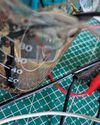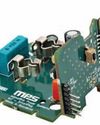WATCHBOT INTRUDER DETECTION Using Pi Camera And VIDEO STORAGE With Telegram Bot
Electronics For You
|December 2023
Vigilance of remote locations on your mobile is an assurance for many individuals across the globe.

In our last article, we shared information about intrusion detection using a PIR sensor and how to store captured images on Firebase, an open source Google Cloud tool. This time, we have included video storage using the Telegram app. Our proposed setup is illustrated in Fig. 1.
Here, a PIR sensor connected to a Raspberry Pi checks for intruders in a room using a motion sensor. If it detects human movement, it captures frames from the camera and sends them to your Telegram bot. Fig. 1 depicts the author's prototype of the observation zone where slight hand movements activate the Pi camera, recording a 5-second video. The bill of materials for this bot is listed in Table 1.
EFY note. Additionally, you will need a 16GB SD card and a 5V 2A DC power source if you already have a Raspberry Pi.

Connection
Fig. 2 shows the circuit diagram of intruder detection using a Pi camera and video storage with the Telegram bot. It is built around Raspberry Pi 4B+ (MOD1), a PIR motion sensor (S1), Pi Camera, and a few jumper wires.

Installation and setup
We have used Python for programming. Before coding, you need to configure Raspbian OS on the Raspberry Pi and install the necessary Pi camera library files.
To use a Raspberry Pi camera (connected via a ribbon cable), first enable the camera interface in the Raspberry Pi configuration settings.
You can do this through the terminal using the following commands:
$ sudo apt-get install python-picamera
$ sudo apt-get installpython3-picamera
Diese Geschichte stammt aus der December 2023-Ausgabe von Electronics For You.
Abonnieren Sie Magzter GOLD, um auf Tausende kuratierter Premium-Geschichten und über 9.000 Zeitschriften und Zeitungen zuzugreifen.
Sie sind bereits Abonnent? Anmelden
WEITERE GESCHICHTEN VON Electronics For You

Electronics For You
Tech Majors Are Racing TOWARDS NET-ZERO - What About You?
Apple, Microsoft, Amazon, Google, Infosys, Wipro—global and Indian firms are heading closer to achieving net-zero emissions, a mandate to combat climate change. Here is what you need to know to start your journey...
12 mins
December 2025

Electronics For You
Miniature IoT WATER TDS And LEVEL MONITOR Cum CONTROLLER
For setups that rely on stored water, clear awareness of tank level and water quality is essential.
3 mins
December 2025

Electronics For You
The Impact Of GENERATIVE AI On The Future Of AUTOMOTIVE AND EVs
Autonomous vehicles, connected ecosystems, and smart factories are only the beginning. Generative Al is pushing the auto industry beyond predictions into a bold era of creativity-from EV design to real-time diagnostics and showroom automation. Here is how GenAl is reshaping innovation across the automotive value chain.
8 mins
December 2025

Electronics For You
How AI Tools Are Making SOFTWARE DEVELOPMENT BETTER
AI is reshaping how we code, debug, and collaborate. From Copilot to automation, it is changing software development in ways worth exploring.
3 mins
December 2025
Electronics For You
How AI Tools Are Making SOFTWARE DEVELOPMENT BETTER
AI is reshaping how we code, debug, and collaborate. From Copilot to automation, it is changing software development in ways worth exploring.
3 mins
December 2025

Electronics For You
5 Interesting Reference Designs FOR SMART HOMES
Smart home devices are transforming the way people interact with their appliances. They make homes more convenient, secure, and energy-efficient. From smart plugs and energy monitors to smart locks and thermostats, reference designs help design engineers create connected products that are easy to use, consume less power, and are reliable. These designs allow you to control devices remotely, track energy use, extend battery life, and automate routines. They provide practical solutions for upgrading homes and small commercial spaces without major modifications.
3 mins
December 2025

Electronics For You
Fancy USB LED VASE
This USB LED vase is a simple yet elegant device that fuses art with electronics to create a decorative lighting display. Powered directly from a standard USB port, it uses readily available components such as MOSFETs, resistors, capacitors, and LEDs to produce a striking, dynamic sequence of lights.
3 mins
December 2025

Electronics For You
"WHAT OTHERS SELL IN FOUR BOXES WE BUILT IN ONE"
Years of custom field work are shaping a product line with its own cloud, its own hardware, and a market that is now beginning to recognise its value.
8 mins
December 2025

Electronics For You
BUILD LARGE LANGUAGE MODELS
Large language models are machine learning models designed for a range of language-related tasks such as text generation and translation. Here’s how open source software can help you build your own large language model.
6 mins
December 2025

Electronics For You
Rare Earth Or Rare Ingenuity? India Remains Between The Two
With China firmly controlling rare earth exports, India confronts a critical moment in its technological trajectory.
8 mins
December 2025
Translate
Change font size

